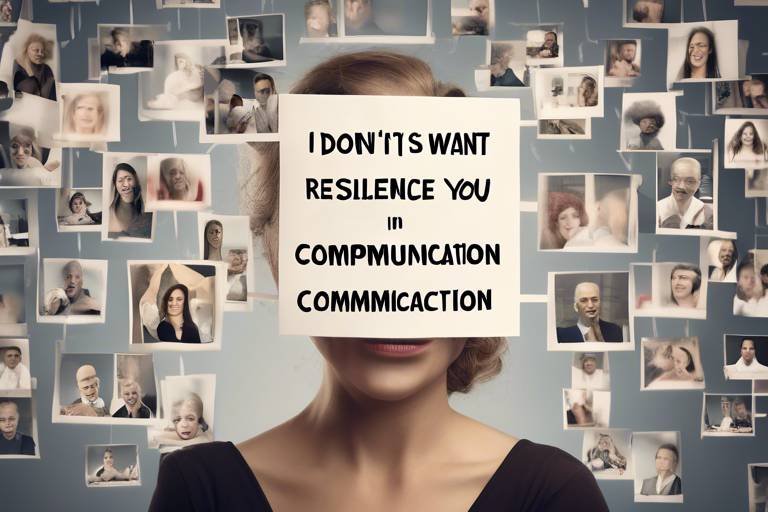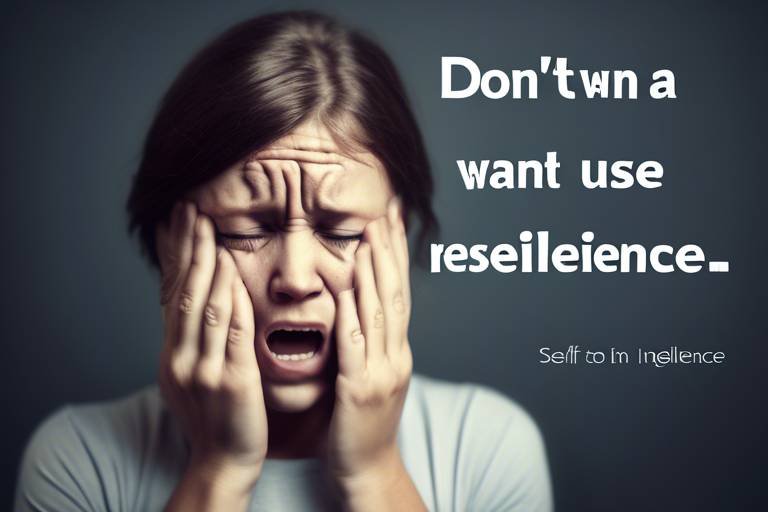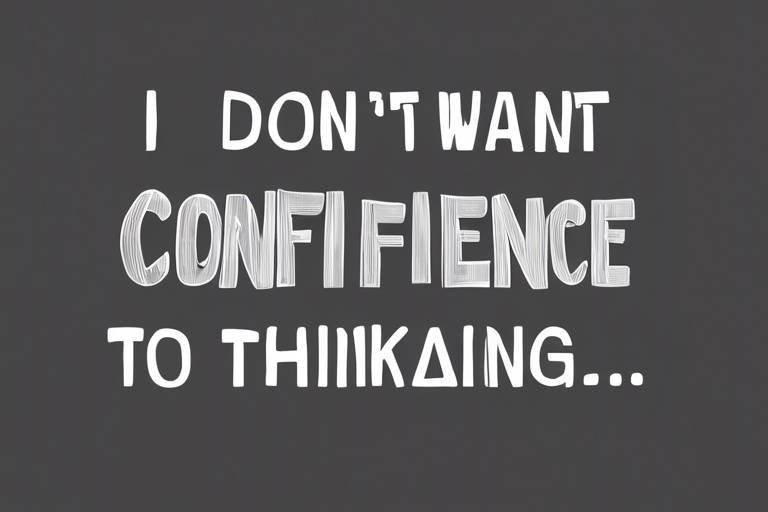Building Resilience - How it Helps in Balancing Work and Family
In today's fast-paced world, the struggle to maintain a healthy balance between work and family can feel like an uphill battle. The demands of our careers often clash with our personal lives, leaving us feeling overwhelmed and stressed. This is where the concept of resilience comes into play. Resilience is not just about bouncing back from setbacks; it's about developing the mental fortitude to navigate life's challenges while keeping our priorities in check. By cultivating resilience, we can equip ourselves with the tools necessary to manage stress, enhance our emotional well-being, and ultimately achieve a harmonious balance between our professional and personal lives.
Imagine resilience as a sturdy bridge that connects the often turbulent waters of work and family life. When we strengthen this bridge, we can traverse the challenges with greater ease. Resilience allows us to adapt to changes, face adversity head-on, and emerge stronger than before. It’s like having a safety net that catches you when you fall, ensuring that even in the toughest times, you can find your footing again. So, how do we build this vital trait? Let's explore the importance of resilience and practical strategies that can help us enhance our ability to cope with life's ups and downs.
Understanding resilience is crucial for navigating life's challenges. It serves as a buffer against stress and helps us maintain emotional equilibrium. In both personal and professional contexts, resilience plays a pivotal role. For instance, when faced with a demanding project at work, a resilient individual can manage their time effectively, seek help when needed, and maintain a positive outlook, rather than succumbing to anxiety. On the home front, resilience enables us to handle family conflicts and unexpected events with grace, ensuring that our relationships remain strong and healthy.
Moreover, resilience is linked to better mental health outcomes. Studies have shown that resilient individuals are less likely to experience depression and anxiety, as they possess the skills to cope with stressors more effectively. They are also more adaptable, which is vital in our ever-changing world. By fostering resilience, we not only improve our own lives but also become role models for our families, teaching them the importance of perseverance and emotional strength.
Now that we understand why resilience is essential, let's delve into some practical strategies that can help us cultivate this invaluable trait. From mindfulness techniques to setting realistic goals, these approaches empower individuals to handle stress and adversity more effectively in their daily lives.
One of the most effective ways to enhance resilience is through mindfulness practices. Mindfulness involves being fully present in the moment, which can significantly reduce stress and increase our ability to cope with challenges. Techniques such as meditation and deep breathing can help individuals stay grounded and focused amidst chaos. When we practice mindfulness, we train our minds to respond rather than react to stressors, allowing us to maintain our composure even in the most trying situations.
Meditation offers numerous benefits for resilience. Regular practice can improve emotional regulation, reduce anxiety, and foster a greater sense of peace. By dedicating just a few minutes each day to meditation, we can create a mental sanctuary that helps us recharge and refocus. This practice is akin to sharpening a tool before use; the sharper the tool, the more effectively we can tackle challenges.
Deep breathing techniques are simple yet powerful tools for resilience. These methods can quickly alleviate stress and promote a sense of calm during challenging situations. For example, when faced with a tight deadline at work, taking a moment to engage in deep breathing can help clear your mind and restore focus. By inhaling deeply through the nose and exhaling slowly through the mouth, we can signal our bodies to relax, turning down the volume on stress and anxiety.
A strong support network is vital for resilience. Having friends, family, or colleagues to rely on during tough times can make a world of difference. This subsection emphasizes the importance of social connections and how nurturing relationships can provide emotional support during tough times. Just like a sturdy tree relies on its roots for stability, we too need a solid support system to weather life's storms.
Achieving work-life balance is essential for overall well-being. It’s about finding that sweet spot where both personal and professional responsibilities coexist without one overshadowing the other. This section offers techniques to manage time effectively, set boundaries, and prioritize tasks, enabling individuals to maintain harmony between work and family.
Effective time management is a key component of work-life balance. By mastering various time management techniques, individuals can allocate their time wisely, reduce stress, and create space for both work and family activities. Techniques like the Pomodoro Technique or time-blocking can help you stay focused and productive while also ensuring you carve out quality time for your loved ones.
Setting boundaries is crucial for maintaining balance. Establishing healthy boundaries at work and home protects personal time and reduces burnout. It’s essential to communicate your limits clearly, whether it’s saying no to extra projects at work or designating family time free from work interruptions. Boundaries are like the fences in a garden; they keep the chaos out and allow the flowers to bloom.
- What is resilience? Resilience is the ability to adapt and bounce back from challenges and adversity.
- How can I build resilience? You can build resilience through mindfulness practices, meditation, deep breathing, and by cultivating a strong support network.
- Why is work-life balance important? Work-life balance is crucial for mental health, relationships, and overall well-being.
- What are some techniques for effective time management? Techniques like the Pomodoro Technique, time-blocking, and prioritizing tasks can help manage time effectively.

The Importance of Resilience
Understanding resilience is crucial for navigating life's challenges, especially in today's fast-paced world where we often find ourselves juggling multiple responsibilities. It's like being a tightrope walker, balancing the demands of work and family while trying not to fall off into the abyss of stress and overwhelm. Resilience is our ability to bounce back from setbacks, adapt to change, and keep moving forward even when the going gets tough. This quality is not just a buzzword; it plays a significant role in both our personal and professional lives.
In the workplace, resilience helps us manage stress more effectively. When faced with deadlines, unexpected challenges, or conflicts with colleagues, resilient individuals are better equipped to handle these situations without becoming overwhelmed. They can maintain a clear perspective, allowing them to make informed decisions rather than reacting impulsively. This ability to stay calm under pressure not only enhances individual performance but also contributes to a more positive work environment. In fact, research shows that organizations with resilient employees experience lower turnover rates and higher productivity levels.
On a personal level, resilience is equally important. Life is full of ups and downs, from family issues to health challenges. Resilient individuals are more likely to cope with these difficulties in a healthy manner. They understand that setbacks are a part of life and view them as opportunities for growth rather than insurmountable obstacles. This mindset allows them to maintain their emotional well-being, fostering a sense of peace and stability even in chaotic times.
Moreover, resilience can serve as a protective factor against mental health issues such as anxiety and depression. When we cultivate resilience, we develop a toolkit of coping strategies that we can draw upon during tough times. This may include seeking support from loved ones, practicing self-care, or engaging in activities that bring us joy. By building resilience, we not only enhance our ability to deal with stress but also improve our overall quality of life.
So, why does resilience matter? Here are a few key reasons:
- Stress Management: Resilience enables us to cope with stress more effectively, reducing the risk of burnout.
- Emotional Well-being: It helps maintain emotional stability, allowing us to navigate life's challenges with a positive outlook.
- Enhanced Performance: In professional settings, resilience contributes to better performance and productivity.
- Stronger Relationships: Resilient individuals often have healthier relationships, as they are more capable of communicating and resolving conflicts.
In summary, resilience is not just a personal trait but a vital skill that can be developed over time. By understanding its importance, we can take proactive steps to cultivate resilience in our lives, ultimately leading to a more balanced and fulfilling existence. As we continue this journey, we will explore practical strategies to build resilience, ensuring that we are well-equipped to handle whatever life throws our way.
What is resilience?
Resilience is the ability to bounce back from challenges, adapt to change, and maintain emotional well-being in the face of adversity.
Why is resilience important?
Resilience is crucial for managing stress, enhancing emotional stability, improving performance at work, and fostering healthier relationships.
How can I build resilience?
Building resilience can involve practices such as mindfulness, setting realistic goals, and nurturing social connections. Each of these strategies contributes to a stronger ability to cope with life's challenges.

Strategies to Build Resilience
Building resilience is not just about bouncing back from setbacks; it's about developing a robust toolkit to navigate life's ups and downs with grace and strength. So, how do we cultivate this essential quality? Let's dive into some practical strategies that can help you enhance your resilience and, in turn, achieve a better balance between work and family life.
One of the most effective ways to foster resilience is through mindfulness practices. Engaging in mindfulness not only helps you stay present but also allows you to observe your thoughts and feelings without judgment. This can be particularly beneficial when you're juggling work responsibilities and family commitments. By taking a moment to breathe deeply and center yourself, you can respond to stressors in a more measured way rather than reacting impulsively. Mindfulness can take many forms, including meditation, yoga, or even simple breathing exercises. Each of these practices can help you cultivate a sense of calm amidst the chaos of daily life.
When it comes to mindfulness, the options are plentiful. For instance, you might find that starting your day with a short meditation session sets a positive tone for the hours ahead. Alternatively, you could integrate mindfulness into your daily routine by taking a few moments to focus on your breath during a hectic workday. Imagine this: you're in the middle of a stressful meeting, and instead of letting anxiety take over, you pause, take a deep breath, and ground yourself in the moment. This small act can make a world of difference.
Meditation, in particular, is a powerful tool for enhancing resilience. Regular practice can lead to improved emotional regulation, which means you're better equipped to handle whatever life throws your way. Studies have shown that those who meditate consistently report lower levels of anxiety and a greater sense of peace. Think of meditation as a mental gym—just as you would train your body, you're training your mind to be more resilient.
Similarly, deep breathing techniques are simple yet incredibly effective for managing stress. When you feel overwhelmed, take a moment to engage in deep breathing. Inhale deeply through your nose, hold for a few seconds, and exhale slowly through your mouth. This technique can quickly alleviate stress and promote a sense of calm. It's like hitting the reset button on your emotional state, allowing you to approach challenges with a clearer mind.
Another critical strategy for building resilience is to cultivate a strong support network. Social connections are vital; they provide emotional support and practical help during tough times. Think of your support network as your personal safety net. Whether it's friends, family, or colleagues, nurturing these relationships can be incredibly beneficial. It's not just about having someone to talk to; it's about knowing that you have people who care about you and are willing to lend a hand when needed. So, reach out, connect, and invest time in building those relationships. They will pay off when the going gets tough.
In summary, building resilience is a multifaceted journey that involves practical strategies like mindfulness practices, meditation, deep breathing, and cultivating strong social connections. By incorporating these techniques into your daily life, you can enhance your ability to manage stress and maintain a healthy balance between work and family. Remember, resilience is not a fixed trait; it's a skill that can be developed over time. So, start today and watch how your life transforms!

Mindfulness Practices
In our fast-paced world, where distractions are as common as coffee breaks, have emerged as a beacon of hope for those seeking balance and tranquility. Imagine trying to navigate a bustling city without a map; that’s what life can feel like without mindfulness. By incorporating mindfulness into our daily routines, we can find clarity and focus amidst the chaos, ultimately enhancing our resilience.
Mindfulness is more than just a buzzword; it's a lifestyle choice that encourages us to be present in the moment. This practice involves paying attention to our thoughts, feelings, and surroundings without judgment. It’s like tuning into your favorite radio station—once you find the right frequency, everything becomes clearer. There are several techniques that can help cultivate mindfulness, and each has its own unique benefits.
One of the most popular mindfulness techniques is meditation. This ancient practice allows individuals to sit quietly, focus on their breath, and observe their thoughts as they come and go. It’s like watching clouds drift by in the sky—some are fluffy and white, while others are dark and stormy. The key is to acknowledge them without getting swept away. Regular meditation can lead to improved emotional regulation, reduced anxiety, and a greater sense of peace.
Another effective mindfulness technique is deep breathing. This simple yet powerful practice can be done anywhere, anytime, making it an ideal tool for busy individuals. When we encounter stressful situations, our bodies often respond with shallow breathing, which can exacerbate feelings of anxiety. By taking a moment to focus on our breath, we can quickly calm our minds and bodies. For instance, try this technique:
| Step | Description |
|---|---|
| 1 | Find a comfortable position, either sitting or standing. |
| 2 | Inhale deeply through your nose for a count of four. |
| 3 | Hold your breath for a count of four. |
| 4 | Exhale slowly through your mouth for a count of four. |
| 5 | Repeat this cycle for a few minutes, focusing on the rhythm of your breath. |
By practicing deep breathing regularly, you can create a mental anchor that helps you remain grounded during turbulent times. It’s like having a life jacket when you’re out at sea; it provides safety and reassurance when the waves of stress come crashing in.
Incorporating mindfulness practices into your daily routine doesn’t have to be overwhelming. Even dedicating just a few minutes each day can yield significant benefits. Whether it’s through meditation, deep breathing, or simply taking a moment to appreciate your surroundings, the key is consistency. As you cultivate these practices, you’ll likely notice a shift in your ability to handle stress and adversity, ultimately enhancing your overall well-being and resilience.

Benefits of Meditation
Meditation is more than just a trendy buzzword; it's a powerful tool that can significantly enhance your resilience in both personal and professional realms. Imagine being able to navigate life's storms with the calmness of a serene lake—this is what regular meditation can help you achieve. By dedicating just a few minutes each day to this practice, you can unlock a treasure trove of benefits that promote emotional stability and mental clarity.
One of the primary benefits of meditation is its ability to improve emotional regulation. When faced with stressful situations, our emotions can often take the wheel, leading to impulsive reactions or overwhelming anxiety. However, through meditation, individuals learn to observe their thoughts and feelings without judgment, allowing them to respond more thoughtfully rather than reactively. This shift can be transformative, especially in high-pressure environments like the workplace, where maintaining composure is crucial.
Additionally, meditation has been shown to reduce anxiety. Picture this: you’re sitting at your desk, deadlines looming, and your mind is racing. A few moments of focused breathing and mindfulness can help ground you, providing clarity amidst chaos. Studies have demonstrated that those who meditate regularly experience lower levels of anxiety, which not only improves their mental health but also enhances their productivity and creativity.
Furthermore, meditation fosters a greater sense of peace and well-being. It encourages a shift in perspective, helping individuals to cultivate gratitude and appreciation for the present moment. This newfound outlook can lead to a more positive attitude towards challenges, making them feel less daunting. When you approach life with a calm and collected mindset, you’re more likely to bounce back from setbacks and maintain balance in your work and family life.
To summarize, the benefits of meditation extend far beyond just relaxation. Here’s a quick overview of how meditation enhances resilience:
- Improves Emotional Regulation: Helps manage emotions effectively.
- Reduces Anxiety: Lowers stress levels and promotes calmness.
- Fosters Peace: Encourages a positive outlook and appreciation for the present.
Incorporating meditation into your daily routine can be a game-changer. Whether you choose to meditate in the morning to set a positive tone for the day or in the evening to unwind, the key is consistency. Just like building a muscle, the more you practice, the stronger your resilience becomes. So, why not give it a try? You might just find that your ability to handle life’s challenges improves dramatically, allowing you to balance work and family with greater ease.
Q: How long should I meditate each day?
A: Even a few minutes of meditation can be beneficial. Start with 5-10 minutes and gradually increase as you become more comfortable with the practice.
Q: Do I need to sit cross-legged to meditate?
A: Not at all! You can meditate in any comfortable position—sitting on a chair, lying down, or even walking. The important part is to find a position that allows you to focus.
Q: Can meditation help with work-related stress?
A: Absolutely! Regular meditation can help you manage stress more effectively, improve your focus, and enhance your overall well-being, making it easier to handle work pressures.
Q: Is meditation suitable for everyone?
A: Yes! Meditation is a versatile practice that can be adapted to fit anyone's needs, regardless of age or background. It's all about finding what works best for you.

Deep Breathing Techniques
In the hustle and bustle of daily life, can serve as a lifeline, pulling us back from the edge of stress and anxiety. Imagine your mind as a busy highway, filled with cars honking, and traffic jams everywhere. Now, picture deep breathing as a quiet side road that leads you away from the chaos, allowing you to regain control and clarity. These techniques are not just about taking a breath; they are about transforming your mental state and cultivating resilience in the face of challenges.
So, how do these techniques work? When we take deep breaths, we activate our body's parasympathetic nervous system, which helps to calm our mind and body. This process can lower heart rates, reduce blood pressure, and even decrease levels of the stress hormone cortisol. It's like hitting the reset button on your emotional state. To help you get started, here are a few effective deep breathing techniques you can incorporate into your daily routine:
- 4-7-8 Breathing: Inhale for 4 seconds, hold your breath for 7 seconds, and exhale slowly for 8 seconds. This technique promotes relaxation and can be particularly useful before bedtime.
- Box Breathing: Inhale for 4 seconds, hold for 4 seconds, exhale for 4 seconds, and hold again for 4 seconds. This method is great for enhancing focus and clarity, making it a perfect choice for the workplace.
- Diaphragmatic Breathing: Place one hand on your chest and the other on your abdomen. Breathe in deeply through your nose, ensuring your abdomen rises more than your chest. This technique encourages full oxygen exchange and is excellent for reducing anxiety.
Integrating these techniques into your daily life can be incredibly beneficial. For instance, you might find a moment of peace during your lunch break or before a big meeting. Even just a few minutes of focused breathing can help you reset and approach tasks with a clearer mind. Think of it as a mini-vacation for your brain, allowing you to step back from stressors and recharge.
Moreover, regular practice of deep breathing can lead to lasting changes in how we respond to stress. Over time, you may find that situations that once triggered anxiety become more manageable. It’s like building a muscle; the more you practice, the stronger you become in handling life’s challenges. So, the next time you feel overwhelmed, remember to take a deep breath. It might just be the simplest yet most effective tool in your resilience toolkit.
Q: How often should I practice deep breathing techniques?
A: It's beneficial to practice deep breathing daily, even if just for a few minutes. Consistency is key to reaping the long-term benefits.
Q: Can deep breathing help with anxiety and panic attacks?
A: Yes, deep breathing can help calm the nervous system and reduce feelings of anxiety during panic attacks. It provides a grounding effect that can make a significant difference.
Q: Are there specific times when I should practice deep breathing?
A: While you can practice deep breathing anytime, it’s particularly helpful during stressful moments, before important events, or as part of your morning or evening routine.

Building a Support Network
In today's fast-paced world, building a strong support network is not just beneficial; it's essential. Think of it as your personal safety net, catching you when life throws its inevitable curveballs. Having a reliable group of friends, family, or colleagues can significantly enhance your resilience, providing emotional support and practical assistance during tough times. But how do we go about creating this network? It starts with recognizing the importance of social connections in our lives.
One of the primary reasons a support network is vital is the emotional backing it provides. When you're faced with challenges, whether at work or home, having someone to talk to can make all the difference. It's like having a flashlight in a dark tunnel; it helps you see the way forward. Moreover, sharing your experiences with others not only lightens your emotional load but also allows you to gain new perspectives on your situation. You might find that others have faced similar challenges and can offer valuable advice or simply a listening ear.
To build a solid support network, consider the following steps:
- Identify Your Needs: Reflect on what kind of support you need. Are you looking for emotional encouragement, practical help, or professional advice? Knowing this will guide you in choosing the right people to include in your network.
- Reach Out: Don’t hesitate to reach out to friends, family, or colleagues. A simple text or call can rekindle connections that may have faded over time. It's important to be proactive in maintaining these relationships.
- Be Open and Vulnerable: Sharing your struggles can be daunting, but vulnerability fosters deeper connections. When you open up about your challenges, you invite others to do the same, strengthening your bond.
- Engage in Community Activities: Joining clubs, volunteering, or participating in local events can introduce you to new people who share your interests. This not only expands your network but also enriches your life with new experiences.
Moreover, nurturing these relationships is crucial. Just as a garden needs water and sunlight to thrive, your support network needs attention and care. Regular check-ins, whether through a quick message or a coffee catch-up, can keep the connections strong. Remember, it's a two-way street; be there for others as much as you seek support. This reciprocity builds trust and deepens relationships, making your network even more robust.
In conclusion, building a support network is a dynamic process that requires effort and intention. It's about surrounding yourself with people who uplift you, challenge you, and stand by you when times get tough. The stronger your network, the more resilient you become, allowing you to navigate the complexities of life with greater ease and confidence.

Work-Life Balance Techniques
Achieving a harmonious work-life balance is more than just a buzzword; it's a necessity for overall well-being. In today’s fast-paced world, where the lines between work and personal life often blur, finding that sweet spot can feel like chasing a mirage. But fear not! With the right techniques, you can carve out time for both your professional responsibilities and your family. Imagine your life as a juggling act, where each ball represents a different aspect—work, family, self-care, and social life. The goal is to keep all those balls in the air without dropping any!
One of the most effective ways to achieve this balance is through effective time management. Think of your time as a precious resource, much like money. If you don't budget it wisely, you'll find yourself overspending in one area and going bankrupt in another. Start by identifying your priorities. What needs immediate attention? What can wait? This awareness allows you to allocate your time more effectively. For instance, you might want to dedicate specific hours of the day solely to family or personal projects, ensuring that work doesn't encroach upon these sacred moments.
Another crucial technique is setting boundaries. This is where the magic happens! Establishing clear boundaries between work and home life is like drawing a line in the sand. When you’re at work, focus on work. When you’re at home, be present with your family. This doesn’t mean you have to ignore work emails after hours, but it does mean you should limit your responses to emergencies only. By doing so, you protect your personal time and reduce the risk of burnout. Consider creating a physical boundary, like a separate workspace in your home. This way, when you step away from that space, you know it’s time to switch gears.
To help visualize this, here’s a simple table that outlines some key techniques for work-life balance:
| Technique | Description |
|---|---|
| Effective Time Management | Prioritize tasks and allocate specific times for work and personal activities. |
| Setting Boundaries | Establish clear lines between work and personal life to reduce stress and enhance focus. |
| Mindfulness Practices | Incorporate mindfulness techniques to stay grounded and manage stress effectively. |
| Building a Support Network | Connect with friends and family for emotional support and shared responsibilities. |
Lastly, don’t underestimate the power of communication. Whether it’s with your boss, your colleagues, or your family, keeping the lines of communication open is essential. If you’re feeling overwhelmed with work, speak up! Most employers appreciate honesty and may offer flexible options or support. Similarly, let your family know when you need uninterrupted time to focus on work. This transparency fosters understanding and cooperation, making it easier for everyone to adjust to your needs.
In summary, balancing work and family life doesn’t have to be an impossible task. By implementing effective time management, setting clear boundaries, and maintaining open communication, you can create a fulfilling life that honors both your professional ambitions and personal relationships. Remember, it's all about finding that balance—like a tightrope walker gracefully navigating the heights, you too can achieve equilibrium in your daily life.
- What is work-life balance? Work-life balance refers to the equilibrium between personal life and work commitments, allowing individuals to manage their time effectively.
- Why is work-life balance important? It’s essential for reducing stress, preventing burnout, and enhancing overall well-being, leading to a more fulfilling life.
- How can I improve my work-life balance? Techniques such as effective time management, setting boundaries, and practicing mindfulness can significantly improve your balance.

Time Management Skills
Time management is not just a buzzword; it's a vital skill that can transform your life, especially when you're juggling the demands of work and family. Think of it as your personal compass, guiding you through the chaos of daily responsibilities. When you master time management, you not only enhance your productivity but also create space for what truly matters—your family, your health, and your peace of mind. But how do you effectively manage your time? Let's dive into some practical strategies!
First things first, it's essential to understand the difference between being busy and being productive. Many people confuse the two, leading to a cycle of endless to-do lists that never seem to shrink. Instead of just filling your day with tasks, focus on prioritizing what truly counts. One effective method is the 80/20 rule, also known as the Pareto Principle, which suggests that 80% of your results come from 20% of your efforts. By identifying those key tasks that yield the most significant outcomes, you can direct your energy where it matters most.
Another powerful technique is to use a time-blocking approach. This involves allocating specific chunks of time for different activities throughout your day. For instance, you might block out two hours in the morning for focused work, followed by a break for lunch, and then another block for family time in the evening. This structure not only helps you stay organized but also ensures that you dedicate quality time to both your professional and personal life.
Here’s a simple table to illustrate how you might structure your day using time-blocking:
| Time | Activity |
|---|---|
| 8:00 AM - 10:00 AM | Focused Work |
| 10:00 AM - 10:15 AM | Break |
| 10:15 AM - 12:00 PM | Meetings/Collaborations |
| 12:00 PM - 1:00 PM | Lunch |
| 1:00 PM - 3:00 PM | Project Work |
| 3:00 PM - 3:15 PM | Break |
| 3:15 PM - 5:00 PM | Family Time |
Moreover, don't underestimate the power of saying no. It's easy to overcommit, especially when you're trying to please everyone. However, being selective about what you take on can free up valuable time and mental energy. Remember, every time you say yes to something that doesn’t align with your priorities, you’re saying no to something that does. So, be intentional about your commitments!
Lastly, consider using digital tools and apps designed for time management. From calendar apps to task managers, these resources can help you track your responsibilities and deadlines effectively. By integrating technology into your routine, you can automate reminders and keep everything organized, allowing you to focus on what’s important.
In conclusion, mastering time management skills is a game-changer in achieving a harmonious balance between work and family life. By prioritizing effectively, using time-blocking techniques, saying no when necessary, and leveraging technology, you can reclaim your time and enhance your overall well-being. So, why not start today? Take a moment to reflect on your current time management strategies and see where you can make improvements. Your future self will thank you!
- What is the best way to prioritize tasks?
Start by identifying your most important tasks using the 80/20 rule. Focus on the tasks that will yield the most significant results. - How can I avoid procrastination?
Break tasks into smaller, manageable steps and set deadlines for each. Using time-blocking can also help you stay focused. - Are there any apps that can help with time management?
Yes! Popular apps like Todoist, Trello, and Google Calendar can help you stay organized and on track.

Setting Boundaries
Setting boundaries is crucial for maintaining balance in our hectic lives. Imagine your life as a jigsaw puzzle; each piece represents a different aspect—work, family, friends, and personal time. If you don’t have clear boundaries, those pieces can start to overlap, creating a chaotic picture that’s hard to manage. Without boundaries, it’s all too easy to find yourself working late into the night or constantly checking emails during family dinners. This not only affects your productivity but also your mental health and relationships.
Establishing clear boundaries allows you to create a buffer between your work and personal life. It’s about defining what you’re comfortable with and what you’re not. For instance, if you’re someone who finds it hard to say no, you might end up taking on extra projects that eat into your family time. By setting boundaries, you can reclaim your time and energy. It’s like putting up a fence around your garden; it keeps the weeds out and allows your flowers to bloom beautifully.
Here are some practical ways to set boundaries effectively:
- Communicate Clearly: Make it known to your colleagues and family when you are available and when you need uninterrupted time. This can be as simple as saying, “I’m not available for meetings after 5 PM” or “I need some quiet time to focus on my work.”
- Use Technology Wisely: Utilize tools like calendar apps to block off personal time. This not only helps you stay organized but also signals to others that you are not to be disturbed during those hours.
- Practice Saying No: It’s okay to decline additional responsibilities if they conflict with your personal time. Remember, saying no to one thing is saying yes to another—often something more important to you.
Setting boundaries is not just about saying no; it’s also about creating a culture of respect in your environment. When you respect your own time and limits, others are more likely to do the same. This can lead to a healthier workplace where everyone understands the importance of work-life balance. Moreover, it can significantly reduce feelings of guilt associated with taking time for yourself or your family.
Boundaries also play a critical role in reducing stress and preventing burnout. When you’re able to disconnect from work, even for short periods, you give your mind a chance to recharge. Think of it like plugging in your phone; if you never take the time to recharge, eventually, it will die. Taking regular breaks to step away from work allows you to return with renewed energy and focus, making you more productive in the long run.
In essence, setting boundaries is about taking control of your life. It’s a personal commitment to yourself and your well-being. By prioritizing your needs and establishing clear limits, you can create a more balanced, fulfilling life that honors both your professional aspirations and your family commitments.
Frequently Asked Questions
- What is resilience, and why is it important?
Resilience is the ability to bounce back from challenges and adversity. It’s crucial because it helps individuals manage stress, maintain emotional well-being, and navigate life's ups and downs more effectively. Think of resilience as a mental muscle; the stronger it is, the better you can handle whatever life throws your way!
- How can I build resilience in my daily life?
You can build resilience through various strategies such as practicing mindfulness, setting realistic goals, and fostering supportive relationships. Incorporating techniques like meditation and deep breathing can also help you stay calm and centered amidst chaos. Remember, resilience is like a garden; the more you nurture it, the more it thrives!
- What role does mindfulness play in resilience?
Mindfulness plays a significant role in enhancing resilience by helping you stay present and focused. Techniques such as meditation and deep breathing allow you to manage stress and improve emotional regulation. It's like having a mental shield that helps you deflect negativity and stay grounded during tough times.
- Can meditation really improve my emotional well-being?
Absolutely! Regular meditation can lead to better emotional regulation, reduced anxiety, and an overall sense of peace. It’s like hitting the reset button for your mind, allowing you to approach challenges with a clearer perspective and a calmer demeanor.
- Why is having a support network important for resilience?
A strong support network provides emotional backing during tough times. Nurturing relationships with friends, family, or colleagues can help you feel less isolated and more empowered. Think of it as having a safety net; when you fall, it catches you!
- What are some effective time management techniques for work-life balance?
Effective time management techniques include prioritizing tasks, using planners, and setting specific time blocks for work and family activities. By allocating your time wisely, you can reduce stress and create a more harmonious balance between your professional and personal life.
- How can I set healthy boundaries at work and home?
Setting healthy boundaries involves communicating your needs clearly and learning to say no when necessary. Establishing limits on work hours and dedicating time for family can help protect your personal space and reduce the risk of burnout. It’s all about creating a balance that works for you!



















